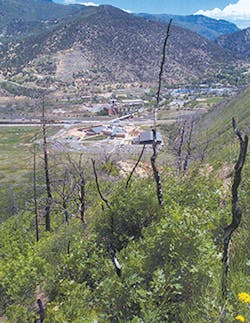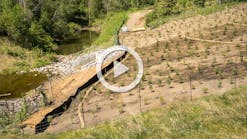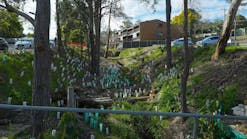Seeding Restoration Sites With Tackifiers, Mulch, and More
An infamous coal seam fire that had been smoldering for 100 years burst out violently in 2002 to devour the arid Colorado landscape. An inferno dating back, perhaps, to a mine explosion in 1896 that killed 49 miners, the fire that erupted to the surface and tore toward Glenwood Springs claimed 12,000 acres and 29 homes before it was doused just short of reaching the urban zone. Fortunately, it was brought under control without any loss of life.
Just after the fire, however, things did not look good for the hillside on the edge of the historic town known for its hot springs and a brief stint as mining hub. A new peril of potentially devastating erosion loomed over the city. “Right after the fire, everything was torched,” says Tom Bowman, president of Bowman Construction, describing the view from that hill over looking the town. He says everything was stripped bare and poised for a major erosive event.
An infamous coal seam fire that had been smoldering for 100 years burst out violently in 2002 to devour the arid Colorado landscape. An inferno dating back, perhaps, to a mine explosion in 1896 that killed 49 miners, the fire that erupted to the surface and tore toward Glenwood Springs claimed 12,000 acres and 29 homes before it was doused just short of reaching the urban zone. Fortunately, it was brought under control without any loss of life. Just after the fire, however, things did not look good for the hillside on the edge of the historic town known for its hot springs and a brief stint as mining hub. A new peril of potentially devastating erosion loomed over the city. “Right after the fire, everything was torched,” says Tom Bowman, president of Bowman Construction, describing the view from that hill over looking the town. He says everything was stripped bare and poised for a major erosive event. [text_ad] It was the kind of scene the US Geological Survey warns of in documents relating to post-fire landslide risk on its website: “Post-fire landslide hazards include fast-moving, highly destructive debris flows that can occur in the year immediately after wildfires in response to high intensity rainfall events, and those flows that are generated over longer time periods accompanied by root decay and loss of soil strength. Post-fire debris flows are particularly hazardous because they can occur with little warning, can exert great impulsive loads on objects in their paths, can strip vegetation, block drainage ways, damage structures, and endanger human life.” At the base of the hill stood a popular community shopping center that, spared the destruction of the flames, stood in the possible path of the debris. “The concern was if that hillside failed it could result in a landslide that would take out the shopping center and send debris and sediment straight into the Colorado River,” about a mile away, says Bowman. The immediate objective of the emergency response team was to reduce the risk of the soil giving way and to stabilize the hill as quickly as possible. As authorities recognized that a major rainstorm could strike at any moment, says Bowman, the team decided to skip straight to remediation, bypassing the customary steps of soil testing and analysis. It was a decision Bowman found reasonable. “We like to see the soil test results, but sometimes it’s too much of an emergency.” The Glenwood Springs area in September 2010, eight years after the original treatment. Areas where native grasses are dormant appear darker; brighter green areas show brush that has grown back. Bowman has written previously of the effect of fire severity on soil structure. “High-intensity fires typically have a more severe and longer-lasting impact on soil life than low-intensity fires. While various nutrients can be available during and after a fire, others may be volatilized and lost. Volatilization is temperature dependent and usually affects nitrogen and, to a lesser extent, sulfur, phosphorus, and carbon. At 140 degrees Fahrenheit soil proteins are eliminated; at 257 degrees Fahrenheit soil is sterilized; and at 392 degrees Fahrenheit nitrogen is lost. Research shows that fire destroys between 33% and 100% of soil humus and microorganisms, depending upon the intensity and severity of the fire. High temperatures can also cause the soil to become hydrophobic and impermeable by water, impeding the water penetration necessary to support plant and soil life. This leads to erosion control and revegetation problems unique to burned sites,” he wrote in a white paper describing Biosol, a soil amendment his company markets. Bringing the hillside back to life with new vegetation as quickly as possible would reduce or eliminate the risk of landslide. The plan to do so would include seeding and soil amendments, but most importantly it would hinge on somehow holding everything together on the steep desiccated slope long enough for the new growth to get a good start. The Bureau of Land Management (BLM) was concerned that dropping material from aircraft might add a factor of disturbance on top of what had already occurred because of the fire, recalls Bowman. However, because of the steep terrain, there really was “no alternative to applying the treatment by air.” Crews mixed Colorado River water with the mulch and ferried it in multiple flights over the treatment zone. To treat the imperiled 500 acres of the hillside, the aerial team distributed 1,100 pounds of wood mulch per acre, which Bowman says was about half the rate usually applied in fire-restoration scenarios, along with Biosol at a rate of 400 pounds per acre. Aircraft dropped 50 pounds of seed and 60 pounds of Supertack tackifier per acre to lock it all in place. Ted Stallings’ firm, Aero Tech, completed the 500-acre installation in just seven days. “The wood-fiber mulch was there to protect the seed and soil from any rains and snow melt; the tackifier is the glue to keep everything in place and keep anything from moving,” says Bowman. “The Biosol has a couple of different qualities. It is a slow-release nitrogen source for revegetation, and it also helps break up the hydrophobic layer that the fire causes.” Biosol also contains chitin, a biological material derived from the shells of crustaceans, that helps counter the hydrophobic layer by “retaining moisture that can be retrieved for use of beneficial microbes and for plant life.” Bowman says the area had numerous rain events after the treatments, but the application of Biosol “was able to help that water penetrate into the subsoil, so you didn’t just have rain and soil sheeting off and running down the slope. Each of the products had different properties, but they all worked together.” The BLM kept a close eye on the results. After one year of monitoring, 77% of seed dropped over the Glenwood Springs hillside had germinated. After two years, a BLM official states, “The plots were very difficult to find, despite the fact that they were marked with 18-inch stakes.” “At one point it looked like someone had Photoshopped green on the mountain; it was amazing,” says Bowman. He contrasts his results using tackifiers, mulch, and Biosol in combination with seeding to the restoration efforts after another major fire in the Colorado area that took place around the same time. In that instance, he says, an aerial drop of seed and straw mulch alone was used, without tackifiers to hold the soils in place. According to Bowman, germination, which topped out at 35%, proved unsatisfactory, and the aerial seeding process had to be repeated up to six times. He notes that one of the keys to the Glenwood Springs project’s success was the addition of the Rantec Corp.’s Supertack tackifier to the mix. “Natural seed can bring a place back, but when these things happen we need sediment control for the period before the roots take hold.” Lindblom remarks, “We are in a current state of learning about how we can coexist with fire. We’ve figured out that fire is going to be here whether we like it or not. We also know that excluding fire from our wild lands is not a great idea. But we don’t really know how to reintroduce it because the landscapes are so altered.” Just as human sensibilities gravitate towards landscapes contoured by water, so perhaps do they also gravitate towards landscapes carved out by fire. From the perspective of a professional naturalist, says Lindblom, “I find fascination with landscapes that are adapted to fire. I find healthy landscapes that include fire as part of the process attractive, not because of the fire per se, but because of the healthy nature of the diversity of the plants and animals that live in those forests and grasslands.”It was the kind of scene the US Geological Survey warns of in documents relating to post-fire landslide risk on its website: “Post-fire landslide hazards include fast-moving, highly destructive debris flows that can occur in the year immediately after wildfires in response to high intensity rainfall events, and those flows that are generated over longer time periods accompanied by root decay and loss of soil strength. Post-fire debris flows are particularly hazardous because they can occur with little warning, can exert great impulsive loads on objects in their paths, can strip vegetation, block drainage ways, damage structures, and endanger human life.”
At the base of the hill stood a popular community shopping center that, spared the destruction of the flames, stood in the possible path of the debris. “The concern was if that hillside failed it could result in a landslide that would take out the shopping center and send debris and sediment straight into the Colorado River,” about a mile away, says Bowman.
The immediate objective of the emergency response team was to reduce the risk of the soil giving way and to stabilize the hill as quickly as possible. As authorities recognized that a major rainstorm could strike at any moment, says Bowman, the team decided to skip straight to remediation, bypassing the customary steps of soil testing and analysis. It was a decision Bowman found reasonable. “We like to see the soil test results, but sometimes it’s too much of an emergency.”
The Glenwood Springs area in September 2010, eight years after the original treatment. Areas where native grasses are dormant appear darker; brighter green areas show brush that has grown back.
Bowman has written previously of the effect of fire severity on soil structure. “High-intensity fires typically have a more severe and longer-lasting impact on soil life than low-intensity fires. While various nutrients can be available during and after a fire, others may be volatilized and lost. Volatilization is temperature dependent and usually affects nitrogen and, to a lesser extent, sulfur, phosphorus, and carbon. At 140 degrees Fahrenheit soil proteins are eliminated; at 257 degrees Fahrenheit soil is sterilized; and at 392 degrees Fahrenheit nitrogen is lost. Research shows that fire destroys between 33% and 100% of soil humus and microorganisms, depending upon the intensity and severity of the fire. High temperatures can also cause the soil to become hydrophobic and impermeable by water, impeding the water penetration necessary to support plant and soil life. This leads to erosion control and revegetation problems unique to burned sites,” he wrote in a white paper describing Biosol, a soil amendment his company markets.
Bringing the hillside back to life with new vegetation as quickly as possible would reduce or eliminate the risk of landslide. The plan to do so would include seeding and soil amendments, but most importantly it would hinge on somehow holding everything together on the steep desiccated slope long enough for the new growth to get a good start.
The Bureau of Land Management (BLM) was concerned that dropping material from aircraft might add a factor of disturbance on top of what had already occurred because of the fire, recalls Bowman. However, because of the steep terrain, there really was “no alternative to applying the treatment by air.”
Crews mixed Colorado River water with the mulch and ferried it in multiple flights over the treatment zone. To treat the imperiled 500 acres of the hillside, the aerial team distributed 1,100 pounds of wood mulch per acre, which Bowman says was about half the rate usually applied in fire-restoration scenarios, along with Biosol at a rate of 400 pounds per acre.
Aircraft dropped 50 pounds of seed and 60 pounds of Supertack tackifier per acre to lock it all in place. Ted Stallings’ firm, Aero Tech, completed the 500-acre installation in just seven days.
“The wood-fiber mulch was there to protect the seed and soil from any rains and snow melt; the tackifier is the glue to keep everything in place and keep anything from moving,” says Bowman. “The Biosol has a couple of different qualities. It is a slow-release nitrogen source for revegetation, and it also helps break up the hydrophobic layer that the fire causes.” Biosol also contains chitin, a biological material derived from the shells of crustaceans, that helps counter the hydrophobic layer by “retaining moisture that can be retrieved for use of beneficial microbes and for plant life.”
Bowman says the area had numerous rain events after the treatments, but the application of Biosol “was able to help that water penetrate into the subsoil, so you didn’t just have rain and soil sheeting off and running down the slope. Each of the products had different properties, but they all worked together.”
The BLM kept a close eye on the results. After one year of monitoring, 77% of seed dropped over the Glenwood Springs hillside had germinated. After two years, a BLM official states, “The plots were very difficult to find, despite the fact that they were marked with 18-inch stakes.”
“At one point it looked like someone had Photoshopped green on the mountain; it was amazing,” says Bowman.
He contrasts his results using tackifiers, mulch, and Biosol in combination with seeding to the restoration efforts after another major fire in the Colorado area that took place around the same time. In that instance, he says, an aerial drop of seed and straw mulch alone was used, without tackifiers to hold the soils in place. According to Bowman, germination, which topped out at 35%, proved unsatisfactory, and the aerial seeding process had to be repeated up to six times.
He notes that one of the keys to the Glenwood Springs project’s success was the addition of the Rantec Corp.’s Supertack tackifier to the mix. “Natural seed can bring a place back, but when these things happen we need sediment control for the period before the roots take hold.”
Lindblom remarks, “We are in a current state of learning about how we can coexist with fire. We’ve figured out that fire is going to be here whether we like it or not. We also know that excluding fire from our wild lands is not a great idea. But we don’t really know how to reintroduce it because the landscapes are so altered.”
Just as human sensibilities gravitate towards landscapes contoured by water, so perhaps do they also gravitate towards landscapes carved out by fire. From the perspective of a professional naturalist, says Lindblom, “I find fascination with landscapes that are adapted to fire. I find healthy landscapes that include fire as part of the process attractive, not because of the fire per se, but because of the healthy nature of the diversity of the plants and animals that live in those forests and grasslands.”






